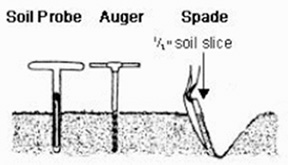
Volume XVII, Issue 39 # September 24 - September 30, 2009 |
 |
|
The Bay Gardener
 by Dr. Frank Gouin |
Don’t Leave Your Lawn to Intuition
There’s a reason grass won’t grow in some areas
September is a great month for top seeding your lawn and for patching those bare spots. September is also a great month for having the soil in your lawn tested to make certain that the soil will produce a great lawn.
I fail to understand why people are so reluctant to have their soil tested and make the necessary corrections after they repeatedly fail to fix the bad areas of their lawn. I’ve seen them throwing grass seed or taking a rake and scratching the soil in bare areas and sowing seeds year after year with the same bad results.

![]() Horticulture is a science and not based on intuition. There is a reason why the grass will not grow in certain areas. Determining the cause starts with a soil test.
Horticulture is a science and not based on intuition. There is a reason why the grass will not grow in certain areas. Determining the cause starts with a soil test.
Your soil could be too compacted.
Soil compaction is often the main reason grass fails to grow. Your soil is too compacted if you are unable to penetrate it with your trowel or soil auger. If you are unable to penetrate the soil with a trowel or shovel, the soil is too compacted to allow roots to grow. The roots of plants cannot penetrate soils that are compacted more than 84 percent. Compacted soil results in shallow rooting, and shallow rooting means that the roots are unable to obtain adequate moisture and nutrients.
When taking soil samples, you should be able to penetrate moist soil six to eight inches.
The second reason your grass fails to grow could be that the soil is too acid or too low in organic matter or plant nutrients. From your soil samples, pH, organic matter concentration and nutrient levels are analyzed.
So save your time and money if you top-seeded or patched spots last year and the lawn still looks the same. This year, take the scientific approach. Take soil samples and have your soil tested.
If you can take soil samples only in the upper inch, you have so major a problem that it would be a waste of time to spread seeds or top dress with fertilizers.
If you take samples from several areas in your lawn and find by analysis that you have a pH of below 6.0, you are wasting your money on both seed and fertilizer.
Learn how to take soil samples and have your soil tested at www.al-labs-eastern.com The more core samples you take from your lawn area, the better the results. For most lawns, take at least six core samples to mix together to make one representative sample.
Attack Bamboo Now!
Q I’ve been working on a bamboo patch for about three years with draconian burning and application of herbicides like Spectra and Roundup to every living shoot. It has, each spring, come forth outside my perimeter.
What, sir, is the trick I need??
–Kent Mountford, Lusby
A In late October, spray bamboo foliage thoroughly with Roundup at the recommended concentration. Repeat the treatment 10 to 14 days later. Spray the foliage on a bright sunny day. The later you can spray in the fall, the better the control. In one of our studies, I delayed spraying until after the first frost, and we had excellent control.
Do not disturb the plants until the following spring. If you get a few shoots, repeat the process again. It normally takes about two years to obtain complete control.